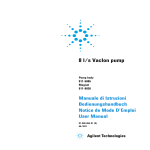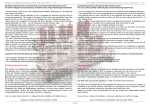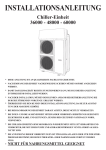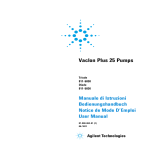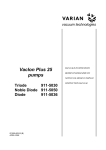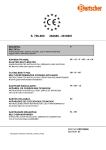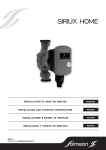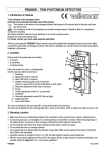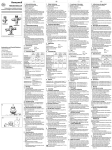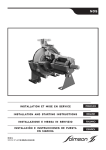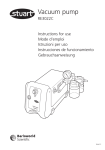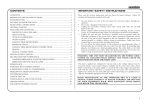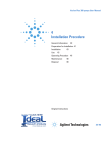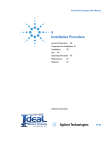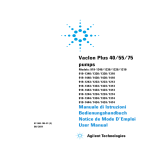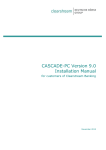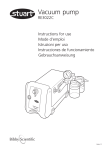Download Miniature and 2 l/s VacIon Pumps
Transcript
Miniature and 2 l/s VacIon Pumps Miniature Models: 913-0037, 913-0038, 913-0040, 913-0041, 913-0049, 913-0050 Magnet: 913-0042 2 l/s Models: 913-0032, 913-0034, 913-0035, 913-0045, 913-0046, 913-0047, 913-0052, 913-5000. Magnet: 913-0011 Manuale di Istruzioni Bedienungshandbuch Notice de Mode D’Emploi User Manual 87-400-044-01 (E) 05/2011 Warranty Notices © Agilent Technologies, Inc. 2011 No part of this manual may be reproduced in any form or by any means (including electronic storage and retrieval or translation into a foreign language) without prior agreement and written consent from Agilent Technologies, Inc. as governed by United States and international copyright laws. Manual Part Number Publication Number: 87-400-044-01 (E) Edition Edition 05/2011 Printed in ITALY Agilent Technologies Italia S.p.A. Vacuum Products Division Via F.lli Varian, 54 10040 Leinì (TO) ITALY The material contained in this document is provided “as is,” and is subject to being changed, without notice, in future editions. Further, to the maximum extent permitted by applicable law, Agilent disclaims all warranties, either express or implied, with regard to this manual and any information contained herein, including but not limited to the implied warranties of merchantability and fitness for a particular purpose. Agilent shall not be liable for errors or for incidental or consequential damages in connection with the furnishing, use, or performance of this document or of any information contained herein. Should Agilent and the user have a separate written agreement with warranty terms covering the material in this document that conflict with these terms, the warranty terms in the separate agreement shall control. Technology Licenses The hardware and/or software described in this document are furnished under a license and may be used or copied only in accordance with the terms of such license. Restricted Rights Legend If software is for use in the performance of a U.S. Government prime contract or subcontract, Software is delivered and licensed as “Commercial computer software” as defined in DFAR 252.227-7014 (June 1995), or as a “commercial item” as defined in FAR 2.101(a) or as “Restricted computer software” as defined in FAR 52.227-19 (June 1987) or any equivalent agency regulation or contract clause. Use, duplication or disclosure of Software is subject to Agilent Technologies’ standard commercial license terms, and nonDOD Departments and Agencies of the U.S. Government will receive no greater than Restricted Rights as defined in FAR 52.227-19(c)(1-2) (June 1987). U.S. Government users will receive no greater than Limited Rights as defined in FAR 52.227-14 (June 1987) or DFAR 252.227-7015 (b)(2) (November 1995), as applicable in any technical data. Trademarks Windows and MS Windows are U.S. registered trademarks of Microsoft Corporation. Safety Notices CAUTION A CAUTION notice denotes a hazard. It calls attention to an operating procedure, practice, or the like that, if not correctly performed or adhered to, could result in damage to the product or loss of important data. Do not proceed beyond a CAUTION notice until the indicated conditions are fully understood and met. WARNING A WARNING notice denotes a hazard. It calls attention to an operating procedure, practice, or the like that, if not correctly performed or adhered to, could result in personal injury or death. Do not proceed beyond a WARNING notice until the indicated conditions are fully understood and met. Miniature and 2 l/s VacIon Pumps User Manual 87-400-044-01 (E) Miniature pumps Miniature pumps Miniature and 2 l/s VacIon Pumps User Manual / 87-400-044-01 (E) 3/52 2 l/s VacIon pumps 2 l/s VacIon pumps 4/52 Miniature and 2 l/s VacIon Pumps User Manual 87-400-044-01 (E) Contents Contents 1 Istruzioni per l’uso 7 Informazioni di Sicurezza 8 Informazioni Generali Installazione 9 11 Note di Funzionamento 13 Condizioni di Funzionamento Anomale Smaltimento 2 15 16 Gebrauchsanleitung 17 Sicherheitshinweise 18 Allgemeine Hinweise 19 Installation 21 Funktionsweise 23 Betriebsstörungen 25 Entsorgung 26 3 Mode d’emploi 27 Informations sur la Sécurité 28 Indications Générales 29 Installation 31 Notes de Fonctionnement 33 Miniature and 2 l/s VacIon Pumps User Manual / 87-400-044-01 (E) 5/52 Contents Conditions de Fonctionnement Anormales 35 Mise au Rebut 36 4 Instructions for Use 37 Safety Information 38 General Information 39 Installation 41 Operating Notes 43 Unusual Operating Conditions Disposal 6/52 45 46 Miniature and 2 l/s VacIon Pumps User Manual 87-400-044-01 (E) Miniature and 2 l/s VacIon Pumps User Manual 1 Istruzioni per l’uso Informazioni di Sicurezza 8 Informazioni Generali 9 Installazione 11 Collegamento dell’unità di controllo 12 Note di Funzionamento 13 Operazione di “bakeout” 14 Condizioni di Funzionamento Anomale 15 Bassa corrente 15 Alta corrente 15 Smaltimento 16 Traduzione delle istruzioni originali 7/52 Istruzioni per l’uso Informazioni di Sicurezza 1 Informazioni di Sicurezza Questa apparecchiatura è destinata ad uso professionale. L'utilizzatore deve leggere attentamente il presente manuale di istruzioni ed ogni altra informazione addizionale fornita dalla Agilent prima dell'utilizzo dell'apparecchiatura. La Agilent si ritiene sollevata da eventuali responsabilità dovute all'inosservanza totale o parziale delle istruzioni, ad uso improprio da parte di personale non addestrato, ad interventi non autorizzati o ad uso contrario alle normative nazionali specifiche. Questo manuale utilizza le seguenti convenzioni: ATTENZIONE! I messaggi di attenzione sono visualizzati prima di procedure che, se non osservate, potrebbero causare danni all'apparecchiatura. AVVERTENZA! I messaggi di avvertenza attirano l'attenzione dell'operatore su una procedura o una pratica specifica che, se non eseguita in modo corretto, potrebbe provocare gravi lesioni personali. NOTA 8/52 Le note contengono informazioni importanti estrapolate dal testo. Miniature and 2 l/s VacIon Pumps User Manual 87-400-044-01 (E) 1 Istruzioni per l’uso Informazioni Generali Informazioni Generali Queste istruzioni contengono informazioni di base per l’installazione e l’uso delle Pompe Miniature e 2 l/s VacIon. La seguente tabella elenca i modelli disponibili: Tab. 1 MODELLO P/N Miniature Con tubo in rame 180 ° 913-0037 Con tubo in rame 90 ° 913-0040 Con tubo in acciaio inossidabile da 3/8” OD 180 ° 913-0038 Con tubo in acciaio inossidabile da 3/8” OD 90 ° 913-0041 Con tubo in rame da 3/8” OD 180 °, preparata sotto vuoto 913-0049 Con tubo in rame da 3/8” OD 90 °, preparata sotto vuoto 913-0050 Magnete in Alnico 913-0042 2 l/s Con tubo in acciaio inossidabile da 3/4” OD 180° 913-0032 Con tubo in Kover-glass da 3/4” OD 913-0034 Con tubo in rame da 3/4” OD 180 °, preparata sotto vuoto 913-0035 Con tubo in acciaio inossidabile corto da 3/4” OD 913-0047 Con tubo in acciaio inossidabile da 3/4” OD 180 °, preparata sotto vuoto 913-0045 Con tubo in acciaio inossidabile da 3/4” OD 90 ° a T 913-0046 Con tubo in rame OFHC da 3/4” OD 913-0052 Con flangia 1 1/3” CF 180 ° preparata sotto vuoto 913-5000 Magnete in Alnico 913-0011 Miniature and 2 l/s VacIon Pumps User Manual / 87-400-044-01 (E) 9/52 1 Istruzioni per l’uso Informazioni Generali Il sistema di pompaggio completo comprende La pompa VacIon, il suo magnete, ed un alimentatore. Queste pompe VacIon funzionano sul principio getter nel campo da 10-3 Torr a meno di 10-9 Torr. Per portare il sistema dalla pressione a meno di 10-3 Torr, è necessaria una pompa di prevuoto. La pompa deve essere alimentata tramite una tensione positiva di 3000-3500 Volt (a circuito aperto). La corrente di alimentazione e quella di corto circuito fornita dall’alimentatore devono corrispondere alla corrente assorbita dalla pompa alla sua massima pressione di esercizio. 10/52 Miniature and 2 l/s VacIon Pumps User Manual 87-400-044-01 (E) 1 Istruzioni per l’uso Installazione Installazione Durante l’installazione, mantenere la pompa ed il sistema puliti. Evitare di toccare le superfici che saranno sotto vuoto. Quando la pompa è aperta all’aria, far attenzione a non introdurre particelle estranee, olio, fondente per saldatura, o qualsiasi sostanza volatile. Pulire accuratamente il sistema prima del collegamento della pompa. Una pulizia del sistema del vuoto con prodotti chimici sarebbe il metodo più completo; tuttavia non utilizzarlo quando sono presenti cavità e fessure che impediscano il risciacquo Normalmente è sufficiente uno sgrassaggio con acetone o metanolo ed un successivo risciacquo con acqua. Per ottenere la massima velocità di pompaggio collegare la pompa al sistema con un tubo il più corto ed il più largo possibile. Per lavorazioni in ultra vuoto, le giunzioni devono essere saldate con gas inerte (TIG), brasate con idrogeno o sotto vuoto. Le guarnizioni nel sistema devono essere di metallo morbido tipo rame ricotto, alluminio o oro. Dopo che la pompa è stata sigillata nel sistema, ricontrollare che l’intero sistema non presenti perdite. Fissare il magnete alla relativa staffa della pompa tramite le viti in dotazione. Miniature and 2 l/s VacIon Pumps User Manual / 87-400-044-01 (E) 11/52 1 Istruzioni per l’uso Installazione Collegamento dell’unità di controllo WARNING! Le tensioni generate dall’unità di controllo ed utilizzate dalle pompe VacIon sono potenzialmente letali. Per operare in sicurezza assicurarsi che il collegamento di massa sia realizzato correttamente. Collegare l’unità di controllo alla pompa come segue: 12/52 1 Collegare la pompa alla massa dell’alimentatore sistemando la molletta di massa sul passante della pompa prima di collegare il cavo di alta tensione. Con i cavi provvisti di filo di massa, collegare il filo di massa ad una massa del sistema. 2 L’alimentatore si collega a massa attraverso il suo cavo di alimentazione. Perciò, per assicurare un circuito completamente collegato a massa, la spina a tre poli del cavo di alimentazione deve essere inserita in una presa con collegamento di terra. Non utilizzare prese di adattamento che non permettano la chiusura del circuito di terra. Miniature and 2 l/s VacIon Pumps User Manual 87-400-044-01 (E) Istruzioni per l’uso Note di Funzionamento 1 Note di Funzionamento Le pompe VacIon funzionano ionizzando il gas mediante una scarica confinata magneticamente (cella Penning). Una tensione di circa 3 kV viene applicata all’anodo mentre i catodi sono mantenuti a massa. Un campo magnetico assiale di circa 1200 gauss impedisce che gli elettroni giungano direttamente all’anodo. Un isolante schermato isola l’anodo dal potenziale di terra. Nel funzionamento corretto della pompa VacIon (con il magnete installato), la corrente assorbita è proporzionale alla pressione (vedere la figura seguente). Figura 1 Curva pressione-corrente Dopo che il sistema ha raggiunto una pressione inferiore ai 10-2 Torr, si può avviare la pompa semplicemente accendendo l’unità di controllo. L’avvio della pompa viene indicato dalla presenza di un assorbimento di corrente da parte dell’unità di controllo. NOTA Prima di scollegare il cavo dell’alimentatore attendere sempre almeno 30 secondi dallo spegnimento dell’alta tensione in modo da permettere che il condensatore dell’alimentatore si scarichi adeguatamente. Miniature and 2 l/s VacIon Pumps User Manual / 87-400-044-01 (E) 13/52 1 Istruzioni per l’uso Note di Funzionamento Operazione di “bakeout” Quando una pompa VacIon non raggiunge la pressione base desiderata e non ci sono perdite, è necessario eseguire un “bakeout” del sistema per eliminare il vapore acqueo. Questa operazione viene eseguita riscaldando la pompa e tutti gli elementi del sistema. 14/52 1 Riscaldare il corpo pompa ed il sistema per mezzo di un forno o elementi riscaldanti ad una temperatura tra 150 e 250 °C (250 °C è la massima temperatura sopportata da molti cavi di alta tensione). Questa temperatura è abbastanza elevata in modo da “degassare” le superfici della pompa dal vapore acqueo senza danneggiare il magnete ed il connettore dell’alta tensione. Occorre fare attenzione che gli altri componenti del sistema sopportino la temperatura di riscaldamento. Il riscaldamento deve essere il più possibile uniforme su tutte le superfici per evitare che il vapore si ricondensi sulle parti più fredde impedendo così il raggiungimento di valori elevati di vuoto. 2 Lasciare accesa l’unità di controllo e controllare che la pressione non superi il valore di 5x10-5 Torr (mbar). Nel caso in cui si superi il suddetto valore, occorre spegnere il riscaldatore e riaccenderlo quando si è ripristinata la bassa pressione. Per controllare i riscaldatori ed i valori di pressione in modo automatico durante il riscaldamento, occorre utilizzare un relè sensibile alla pressione. 3 Riscaldare la pompa VacIon per almeno 8 ore. Periodi più lunghi di riscaldamento sono necessari quando la pompa deve essere usata con carichi di gas pesanti, o quando si desiderano valori di vuoto ultra alti (10-9 Torr [mbar]) o inferiori. 4 A mano a mano che la pompa ed il sistema ritornano alla temperatura ambiente, si deve osservare un abbassamento della pressione. 5 Tra le varie applicazioni delle pompe ioniche c’è anche la possibilità del loro impiego per processare sotto vuoto altri componenti. Poichè il passante di alta tensione può sopportare un numero limitato di cicli di riscaldamento (fino a 400 °C), si raccomanda di limitare tali cicli al minimo possibile, per aumentare la durata di vita della pompa stessa. Miniature and 2 l/s VacIon Pumps User Manual 87-400-044-01 (E) 1 Istruzioni per l’uso Condizioni di Funzionamento Anomale Condizioni di Funzionamento Anomale Bassa corrente Se il valore di corrente letto è inferiore a quello normale per quel dato valore di pressione (vedere il diagramma precedente), la scarica si potrebbe essere fermata. Per verificare se la scarica si è fermata, rimuovere il magnete ed osservare la corrente residua. Se la corrente non cambia con e senza il magnete, non è in corso alcuna scarica nella pompa. a Per riavviare la scarica, colpire il corpo pompa con un attrezzo di plastica morbida, o riscaldarlo localmente con un piccolo saldatore. In questo modo si libera del gas dalla superficie all’interno della pompa e la scarica dovrebbe riprendere. NON COLPIRE MAI la pompa con un attrezzo metallico. b Se il campo magnetico scende sotto il suo valore di targa, la scarica della pompa e la velocità si ridurranno e la scarica potrebbe spegnersi ad una pressione inferiore a 1x10-7 Torr. Alta corrente Se il valore di corrente letto è superiore a quello normale per quel dato valore di pressione (vedere il diagramma precedente), controllare quanto segue: a Che il cavo dell’alta tensione non sia in corto circuito. Riparare o sostituire. b Che non ci sia una dispersione all’interno dell’unità di controllo. Riparare secondo quanto indicato sul relativo manuale. c Che non ci sia un corto circuito sugli isolatori di supporto dell’anodo causato da frammenti di film di Titanio. Colpire la pompa come descritto al passo a) del paragrafo precedente potrebbe porre rimedio a questa situazione. Miniature and 2 l/s VacIon Pumps User Manual / 87-400-044-01 (E) 15/52 1 Istruzioni per l’uso Smaltimento d Che non ci sia una emissione di corrente da “punte” che si siano formate sui catodi. Applicare alla pompa una tensione tra 10 e 14 kVac con una corrente tra 20 e 30 mA per 5 - 20 secondi per bruciare le “punte”. e Che non ci siano rivestimenti di film metallici conduttori sugli isolatori a causa di un funzionamento sopra i 10-2 Torr per elevati periodi di tempo. Poiché non è possibile smontare la pompa, questa condizione è causa di una limitazione del tempo di vita della pompa. Evitare di usare la pompa ad alte pressioni per lunghi periodi. Smaltimento Significato del logo "WEEE" presente sulle etichette. Il simbolo qui sotto riportato è applicato in ottemperanza alla direttiva CE denominata "WEEE". Questo simbolo (valido solo per i paesi della Comunità Europea) indica che il prodotto sul quale è applicato, NON deve essere smaltito insieme ai comuni rifiuti domestici o industriali, ma deve essere avviato ad un sistema di raccolta differenziata. Si invita pertanto l'utente finale a contattare il fornitore del dispositivo, sia esso la casa madre o un rivenditore, per avviare il processo di raccolta e smaltimento, dopo opportuna verifica dei termini e condizioni contrattuali di vendita. 16/52 Miniature and 2 l/s VacIon Pumps User Manual 87-400-044-01 (E) Miniature and 2 l/s VacIon Pumps User Manual 2 Gebrauchsanleitung Sicherheitshinweise 18 Allgemeine Hinweise 19 Installation 21 Anschluss des Controllers 22 Funktionsweise 23 Bakeout 24 Betriebsstörungen 25 Stromstärke zu niedrig 25 Stromstärke zu hoch 25 Entsorgung 26 Übersetzung der Originalanleitungen 17/52 2 Gebrauchsanleitung Sicherheitshinweise Sicherheitshinweise Dieses Gerät ist für den professionellen Gebrauch bestimmt. Vor dem Gebrauch soll der Benutzer dieses Handbuch sowie alle weiteren von Agilent mitgelieferten Zusatzinformationen genau lesen. Bei vollständiger bzw. teilweiser Nichtbeachtung der enthaltenen Hinweise, unsachgemäßem Gebrauch durch ungeschultes Personal, nicht autorisierten Eingriffen und Benutzung unter Missachtung der einschlägigen nationalen Bestimmungen übernimmt Firma Agilent keinerlei Haftung. In diesem Handbuch werden bestimmte Textstellen wie folgt hervorgehoben: VORSICHT! Die Vorsichtshinweise vor bestimmten Prozeduren machen darauf aufmerksam, dass bei Nichteinhaltung Schäden am Gerät entstehen können. WARNUNG! Die Warnhinweise richten die Aufmerksamkeit auf eine spezielle Prozedur oder Praktik, die bei unkorrekter Ausführung schwere Personenschäden zur Folge haben könnte. HINWEIS 18/52 Die HINWEISE enthalten wichtige Informationen, die aus dem Text hervorgehoben werden. Miniature and 2 l/s VacIon Pumps User Manual 87-400-044-01 (E) 2 Gebrauchsanleitung Allgemeine Hinweise Allgemeine Hinweise Diese Anweisungen enthalten Grundinformationen zur Installation und zum Gebrauch von Vaclon Pumpen Mod. Miniature und 2 l/s. In der Tabelle werden die erhältlichen Modelle aufgeführt: Tab. 1 MODELL P/N Miniatur Mit Rohr in Kupfer 180 ° 913-0037 Mit Rohr in Kupfer 90 ° 913-0040 Mit Rohr in Edelstahl 3/8” OD 180 ° 913-0038 Mit Rohr in Edelstahl 3/8” OD 90 ° 913-0041 Mit Rohr in Kupfer 3/8” OD 180 °, mit Vorvakuum 913-0049 Mit Rohr in Kupfer 3/8” OD 90 °, mit Vorvakuum 913-0050 Magnet in Alnico 913-0042 2 l/s Mit Rohr in Edelstahl 3/4” OD 180° 913-0032 Mit Rohr in Kover-glass 3/4" OD 913-0034 Mit Rohr in Kupfer 3/4” OD 180 °, mit Vorvakuum 913-0035 Mit Rohr in Edelstahl 3/4” OD 180 °, mit Vorvakuum 913-0045 Mit Rohr in Edelstahl 3/4” OD 90 ° T-Anschluss 913-0046 Mit Kurzer Rohr in Edelstahl 3/4” OD 913-0047 Mit Rohr in OFHC Kupfer 3/4” OD 913-0052 Mit Flansch 1 1/3” CF 180 °, mit Vorvakuum 913-5000 Magnet in Alnico 913-0011 Miniature and 2 l/s VacIon Pumps User Manual / 87-400-044-01 (E) 19/52 2 Gebrauchsanleitung Allgemeine Hinweise Das komplette Pumpsystem umfasst die Vaclon Pumpe, deren Magneten und ein Netzgerät. Diese Vaclon Pumpen arbeiten nach dem Getterprinzip im Bereich von 10-3 Torr bis unter 10-9 Torr. Um das System auf unter 10-3 Torr zu bringen, ist eine Vorvakuumpumpe erforderlich. Die Pumpe ist mit einer Plusspannung von 3.000 - 3.500 Volt (im offenen Schaltkreis) zu versorgen. Die Versorgungsspannung und die vom Netzgerät gelieferte Kurzschlussspannung sollen der Stromaufnahme der Pumpe bei ihrem maximalen Arbeitsdruck entsprechen. 20/52 Miniature and 2 l/s VacIon Pumps User Manual 87-400-044-01 (E) 2 Gebrauchsanleitung Installation Installation Bei der Installation sind die Pumpe und das System sauber zu halten. Die Berührung von Oberflächen, die unter Vakuum sein werden, ist zu vermeiden. Bei geöffnetem Zustand der Pumpe ist darauf zu achten, dass keine Schmutzpartikel, Öl, Lötflussmittel oder flüchtige Substanzen eindringen. Vor Anschluss der Pumpe ist das System gründlich zu reinigen. Eine Reinigung des Vakuumsystems mit chemischen Produkten wäre hierbei die beste Methode; sie sollte allerdings nicht bei Vorhandensein von Hohlräumen und Spalten angewendet werden, die das Ausspülen verhindern. In der Regel ist das Entfetten mit Aceton oder Methanol und das anschließende Spülen mit Wasser ausreichend. Um eine maximale Pumpgeschwindigkeit zu erzielen, ist die Pumpe über eine möglichst kurze und breite Leitung an das System anzuschließen. Für den Höchstvakuumbetrieb sollen die Verbindungen mit Inertgas geschweißt (WIG) und wasserstoff- oder vakuumgelötet sein. Die Dichtungen im System sollen aus Weichmetall wie geglühtes Kupfer, Aluminium oder Gold sein. Nachdem die Pumpe im System versiegelt wurde, ist das gesamte System auf Leckstellen zu überprüfen. Den Magneten an den hierfür vorgesehenen Bügel der Pumpe mit den mitgelieferten Schrauben befestigen. Miniature and 2 l/s VacIon Pumps User Manual / 87-400-044-01 (E) 21/52 2 Gebrauchsanleitung Installation Anschluss des Controllers WARNUNG! Die Spannungen, die vom Controller erzeugt und von Vaclon Pumpen genutzt werden, sind potenziell tödlich. Um die Sicherheitsbedingungen beim Arbeiten zu gewährleisten, ist sicherzustellen, dass der Masseanschluss vorschriftsgemäß ausgeführt ist. Den Controller wie folgt an die Pumpe anschließen: 22/52 1 Die Pumpe an den Masseanschluss des Netzgerätes anschließen, wobei die Masseanschlussfeder am Hochspannungsverbinder der Pumpe anzubringen ist, bevor das Hochspannungskabel angeschlossen wird. Bei den Kabeln, die mit einem Masseleiter versehen sind, ist der Masseleiter an einen Masseanschlusspunkt des Systems anzuschließen. 2 Das Netzgerät wird über sein Versorgungskabel an die Masse angeschlossen. Damit der Stromkreis vollständig an die Masse angeschlossen ist, muss der dreipolige Stecker des Versorgungskabels an eine geerdete Steckdose angeschlossen sein. Es dürfen keine Adaptersteckdosen verwendet werden, die keine Schließung des Erdungskreises zulassen. Miniature and 2 l/s VacIon Pumps User Manual 87-400-044-01 (E) 2 Gebrauchsanleitung Funktionsweise Funktionsweise Vaclon Pumpen arbeiten durch Gasionisierung infolge einer magnetisch abgegrenzten Entladung (Penning-Zelle). An die Anode wird eine Spannung von ungefähr 3 kV angelegt, während die Katoden an die Masse angeschlossen sind. Ein axiales Magnetfeld von ungefähr 1.200 Gauss verhindert, dass die Elektronen direkt zur Anode gelangen. Ein abgeschirmter Isolator isoliert die Anode vom Erdungspotenzial. Bei ordnungsgemäßem Betrieb der Vaclon Pumpe (mit dem installierten Magnet) ist die Stromaufnahme proportional zum Druck (siehe nachstehende Abbildung). Abbildung 1 Druck-Stromstärke-Diagramm Nachdem das System einen Druck unter 10-2 Torr erreicht hat, ist es möglich, die Pumpe lediglich durch Einschalten des Controllers zu starten. Der Pumpenstart ist anhand der Stromaufnahme durch den Controller erkenntlich. HINWEIS Bevor das Kabel des Netzgerätes abgetrennt wird, sind stets mindestens 30 s nach Abschaltung der Hochspannung abzuwarten, damit sich der Kondensator des Netzgerätes entsprechend entladen kann. Miniature and 2 l/s VacIon Pumps User Manual / 87-400-044-01 (E) 23/52 2 Gebrauchsanleitung Funktionsweise Bakeout Wenn eine VacIon Pumpe den gewünschten Basisdruck nicht erreicht und keine Druckverluste vorhanden sind, ist ein Bakeout des Systems aus-zuführen, um den Wasserdampf zu beseitigen. Dieser Vorgang erfolgt unter Erwärmung der Pumpe und aller Systemelemente. 24/52 1 Den Pumpenkorpus und das System mit ei-nem Ofen oder Heizelementen auf eine Temperatur zwischen 150 und 250 °C erhitzen (250 °C ist die maximal zulässige Temperatur vieler Hochspannungskabel). Diese Temperatur ist ausreichend, um die Oberflächen der Pumpe von Wasserdampf zu “entgasen”, ohne den Magneten oder den Hochspannungsverbinder zu beschädigen. Es ist darauf zu achten, dass die anderen Systemkomponenten der Erwärmungstemperatur standhalten. Die Erwärmung soll möglichst gleichmäßig auf allen Oberflächen erfolgen, damit der Dampf nicht an den kälteren Teilen kondensiert und das Erreichen hoher Vakuumwerte verhindert. 2 Den Controller eingeschaltet lassen und kontrollieren, dass der Druck nicht 5x10-5 Torr (mbar) übersteigt. Falls dieser Wert überschritten wird, ist das Heizgerät auszuschalten und erneut einzuschalten, wenn der Unterdruckbereich wieder hergestellt ist. Zur automatischen Kontrolle der Heizgeräte und Druckwerte während der Erwärmung ist ein druckempfindliches Relais zu benutzen. 3 Die Vaclon Pumpe über einen Zeitraum von mindestens 8 Stunden erwärmen. Längere Erwärmzeiten sind erforderlich, wenn die Pumpe mit hohen Gaslasten benutzt werden soll oder Höchstvakuumwerte (10-9 Torr [mbar]) oder niedriger erreicht werden sollen. 4 Im Zuge der Abkühlung der Pumpe und des Systems auf die Umgebungstemperatur muss auch ein Druckabfall entstehen. 5 Zu den verschiedenen Einsatzmöglichkeiten der Ionenpumpen zählt auch die Vakuumerzeugung in anderen Komponenten. Da Hochspannungsverbinder nur einer begrenzten Anzahl von Erwärmungszyklen (bis zu 400 °C) standhalten, sollten diese Zyklen auf ein Mindestmaß beschränkt werden, um die Standzeit der Pumpe zu verlängern. Miniature and 2 l/s VacIon Pumps User Manual 87-400-044-01 (E) 2 Gebrauchsanleitung Betriebsstörungen Betriebsstörungen Stromstärke zu niedrig Wenn die angezeigte Stromstärke unter dem Normwert für den betreffenden Druck liegt (siehe vorhergehendes Diagramm), könnte die Entladung gestoppt sein. Um zu überprüfen, ob die Entladung gestoppt ist, ist der Magnet zu entfernen und die Reststromstärke zu beobachten. Wenn die Stromstärke sich weder mit noch ohne Magneten verändert, findet keine Pumpenentladung statt. a Zur erneuten Entladungsaktivierung, ist mit einem weichen Kunststoffwerkzeug gegen den Pumpenkorpus zu schlagen oder der Pumpenkorpus lokal mit einem kleinen Schweißgerät zu erhitzen. Auf diese Weise löst sich Gas von den Innenflächen der Pumpe und müsste die Entladung wieder aufgenommen werden. Gegen die Pumpe darf NIEMALS mit einem metallenen Werkzeug GESCHLAGEN werden. b Wenn das Magnetfeld unter den Kennschildwert sinkt, verringern sich die Pumpenentladung und -geschwindigkeit, hierbei könnte die Entladung bei einem Druck unter 1x10-7 Torr aussetzen. Stromstärke zu hoch Wenn die angezeigte Stromstärke über dem Normwert für den betreffenden Druck liegt (siehe vorhergehendes Diagramm), sind folgende Kontrollen auszuführen: a Das Hochspannungskabel darf nicht kurzgeschlossen sein. Reparieren oder auswechseln. b Im Controller darf kein Leckstrom vorhanden sein. Gemäß der Angaben aus dem diesbezüglichen Handbuch reparieren. Miniature and 2 l/s VacIon Pumps User Manual / 87-400-044-01 (E) 25/52 2 Gebrauchsanleitung Entsorgung c An den Hilfsisolatoren der Anode darf kein Kurzschluss durch Titanfolienteile anliegen. Wie unter Schritt a) des vorhergehenden Abschnitts gegen die Pumpe schlagen, was dieses Problem beheben könnte. d Es darf keine Stromabgabe durch “Spitzen” erfolgen, die sich an den Katoden gebildet haben. An die Pumpe eine Spannung zwischen 10 und 14 kVAC mit einer Stromstärke zwischen 20 und 30 mA über einen Zeitraum von 5–20 s anlegen, um die “Spitzen” abzubrennen. e An den Isolatoren dürfen keine Metallfilmbeläge vorhanden sein, die infolge eines längeren Betriebs bei einem Druck über 10-2 Torr entstehen. Da die Pumpe nicht demontiert werden kann, bewirkt dies eine kürzere Standzeit des Gerätes. Die längerfristige Benutzung der Pumpen bei hohen Drücken ist zu vermeiden. Entsorgung Bedeutung des "WEEE" Logos auf den Etiketten. Das folgende Symbol ist in Übereinstimmung mit der EURichtlinie WEEE (Waste Electrical and Electronic Equipment) angebracht. Dieses Symbol (nur in den EU-Ländern gültig) zeigt an, dass das betreffende Produkt nicht zusammen mit Haushaltsmüll entsorgt werden darf sondern einem speziellen Sammelsystem zugeführt werden muss. Der Endabnehmer sollte daher den Lieferanten des Geräts - d.h. die Muttergesellschaft oder den Wiederverkäufer - kontaktieren, um den Entsorgungsprozess zu starten, nachdem er die Verkaufsbedingungen geprüft hat. 26/52 Miniature and 2 l/s VacIon Pumps User Manual 87-400-044-01 (E) Miniature and 2 l/s VacIon Pumps User Manual 3 Mode d’emploi Informations sur la Sécurité 28 Indications Générales 29 Installation 31 Branchement de l'unité de contrôle 32 Notes de Fonctionnement 33 Opération de “bakeout” 34 Conditions de Fonctionnement Anormales 35 Courant faible 35 Courant élevé 35 Mise au Rebut 36 Traduction de la mode d’emploi originale 27/52 3 Mode d’emploi Informations sur la Sécurité Informations sur la Sécurité Cet appareillage a été conçu en vue d'une utilisation professionnelle. Il est conseillé à l'utilisateur de lire attentivement cette notice d'instructions ainsi que toute autre indication fournie par Agilent avant d'utiliser l'appareil. Agilent décline par conséquent toute responsabilité en cas de non-respect total ou partiel des instructions fournies, d'utilisation incorrecte de la part d'un personnel non formé, d'opérations non autorisées ou d'un emploi contraire aux réglementations nationales spécifiques. Cette notice utilise les signes conventionnels suivants: ATTENTION! Les messages d'attention apparaissent avant certaines procédures dont le nonrespect peut endommager sérieusement l'appareillage. AVERTISSEMENT! Les messages d’avertissement attirent l'attention de l'opérateur sur une procédure ou une manœuvre spéciale dont la mauvaise exécution risque de provoquer de graves lésions au personnel. NOTE 28/52 Les notes contiennent des renseignements importants, extrapolés du texte. Miniature and 2 l/s VacIon Pumps User Manual 87-400-044-01 (E) 3 Mode d’emploi Indications Générales Indications Générales Ces instructions contiennent des informations de base pour l'installation et l'utilisation des pompes miniature et 2 l/s Vaclon. Le tableau ci-dessous énumère les modèles disponibles : Tab. 1 MODÈLE P/N Miniature Avec tuyau en cuivre 180° 913-0037 Avec tuyau en cuivre 90° 913-0040 Avec tuyau en acier inoxydable de 3/8” ØE 180 ° 913-0038 Avec tuyau en acier inoxydable de 3/8” ØE 90 ° 913-0041 Avec tuyau en cuivre de 3/8” ØE 180 °, préparée sous vide 913-0049 Avec tuyau en cuivre de 3/8” ØE 90 °, préparée sous vide 913-0050 Aimant en Alnico 913-0042 2 l/s Avec tuyau en acier inoxydable de 3/4” ØE 180 ° 913-0032 Avec tuyau en Kover-glass 3/4” ØE 913-0034 Avec tuyau en cuivre de 3/4” ØE 180 °, préparée sous vide 913-0035 Avec tuyau en acier inoxydable de 3/4” ØE 180 °, préparée sous vide 913-0045 Avec tuyau en acier inoxydable de 3/4” ØE 90 ° en T 913-0046 Avec tuyau courte en acier inoxydable de 3/4” ØE 913-0047 Avec tuyau en cuivre OFHC de 3/4” ØE 913-0052 Avec flasque 1 1/3” CF 180 ° préparée sous vide 913-5000 Aimant en Alnico 913-0011 Miniature and 2 l/s VacIon Pumps User Manual / 87-400-044-01 (E) 29/52 3 Mode d’emploi Indications Générales Le système de pompage complet comprend: la pompe Vaclon, son aimant et un alimentateur. Cette pompe Vaclon fonctionne sur le principe getter dans une plage de 10-3 Torr à moins de 10-9 Torr. Pour porter le système de la pression à moins de 10-3 Torr, il est nécessaire de disposer d'une pompe de prévide. La pompe doit être alimentée avec une tension positive de 3000 – 3500 Volts (à circuit ouvert). Le courant d'alimentation et le courant de court-circuit fournis par l'alimentateur doivent correspondre au courant absorbé par la pompe à sa pression d'exercice maximum. 30/52 Miniature and 2 l/s VacIon Pumps User Manual 87-400-044-01 (E) 3 Mode d’emploi Installation Installation Pendant l'installation, maintenir la pompe et le système propres. Éviter de toucher les parties qui seront sousvide. Lorsque la pompe est ouverte à l'air libre, faire attention de ne pas y introduire de particules étrangères, huile, fondant de soudage ou toute autre substance volatile. Nettoyer soigneusement le système avant le montage de la pompe. Un nettoyage du système du vide à l'aide de produits chimiques serait la méthode la plus complète. Il est cependant conseillé de ne pas l'utiliser en présence de cavités ou de fissures empêchant le rinçage. Normalement un dégraissage à l'acétone ou au méthanol suivis d'un rinçage à l'eau sont suffisants. Pour atteindre la vitesse maximale de pompage, relier la pompe au système à l'aide du tuyau le plus court et le plus large possible. Pour les opérations sous vide ultra poussé, les joints doivent être soudés au gaz inerte (TIG), et soumis à un brasage à l'hydrogène ou sousvide. Les joints du système doivent être en métal souple de type cuivre recuit, aluminium ou or. Après le scellage de la pompe dans le système, recontrôler que l'ensemble ne présente aucune fuite. Fixer l'aimant à la bride de la pompe à l'aide des vis fournies. Miniature and 2 l/s VacIon Pumps User Manual / 87-400-044-01 (E) 31/52 3 Mode d’emploi Installation Branchement de l'unité de contrôle AVERTISSEMENT! Les tensions générées par l'unité de contrôle et utilisées par les pompes Vaclon sont potentiellement mortelles. Pour opérer en toute sécurité, vérifier que le branchement à la masse soit correctement réalisé. Relier l'unité de contrôle à la pompe en opérant de la façon suivante : 32/52 1 Relier la pompe à la masse de l'alimentateur en plaçant la molette de masse sur le passant de la pompe avant de brancher le câble de haute tension. En présence de câbles pourvus d'un fil de masse, celui-ci doit être relié à une masse du système. 2 L'alimentateur se relie à la masse par son câble d'alimentation. Pour garantir un circuit entièrement relié à la masse, la fiche à trois pôles du câble d'alimentation doit être introduire dans une prise avec liaison à la terre. Ne pas utiliser de prise d'adaptation qui ne permettent pas la fermeture du circuit de terre. Miniature and 2 l/s VacIon Pumps User Manual 87-400-044-01 (E) 3 Mode d’emploi Notes de Fonctionnement Notes de Fonctionnement Les pompes Vaclon fonctionnent en ionisant le gaz à travers une décharge confinée magnétiquement (cellule Penning). Une tension d'environ 3 kV est appliquée à l'anode alors que les cathodes sont maintenues à la masse. Un champ magnétique axial d'environ 1200 gauss empêche que les électrons arrivent directement à l'anode. Un isolant blindé isole l'anode du potentiel de terre. Dans le fonctionnement correct de la pompe Vaclon, (avec aimant installé), le courant absorbé est proportionnel à la pression (voir figure suivante). Figure 1 Courbe pression – courant Après que le système a atteint une pression inférieure à 10-2 Torr, il est possible de démarrer la pompe en allumant simplement l'unité de contrôle. La mise en marche de la pompe est signalée par la présence d'une absorption de courant par l'unité de contrôle. NOTE Avant de débrancher le câble de l'alimentateur, toujours attendre au moins 30 secondes après la coupure de la haute tension de façon à permettre au condensateur de l'alimentateur de se décharger correctement. Miniature and 2 l/s VacIon Pumps User Manual / 87-400-044-01 (E) 33/52 3 Mode d’emploi Notes de Fonctionnement Opération de “bakeout” Lorsqu'une pompe VacIon n'atteint pas la pression de base désirée et qu'il n'y a aucune fuite, il est nécessaire de procéder à un "bakeout" du système afin d'éliminer la vapeur d'eau. Cette opération est effectuée en chauffant la pompe et tous les éléments du système. 34/52 1 Réchauffer le corps de la pompe et le système à l'aide d'un four ou éléments chauffants à une température comprise entre 150 et 250 °C (250 °C est la température maximum supportée par de nombreux câbles de haute tension). Cette température est suffisamment élevée pour "dégazer" les surfaces de la pompe de la vapeur d'eau sans endommager l'aimant et le connecteur de haute tension. Faire attention que les autres composants du système supportent la température de chauffage. Le chauffage doit être le plus uniforme possible sur toutes les superficies pour éviter que la vapeur ne se recondense sur les parties plus froides, empêchant d'atteindre les valeurs de vide élevées. 2 Laisser l'unité de contrôle allumée et contrôler que la pression ne dépasse pas la valeur de 5x10-5 Torr (mbar). En cas de dépassement de ladite valeur, éteindre l'appareil de chauffage et le rallumer lorsque la basse pression est rétablie. Pour contrôler les appareils de chauffage et les valeurs de pression en mode automatique pendant le chauffage, utiliser un relais sensible à la pression. 3 Chauffer la pompe Vaclon pendant 8 heures minimum. Une période de chauffage plus longue est nécessaire lorsque la pompe doit être utilisée avec de fortes charges de gaz ou lorsque l'on désire des valeurs de vide poussé très élevées (10-9 Torr [mbar]) ou inférieures. 4 Au fur et à mesure que la pompe et le système retournent à la température ambiante, on doit noter un abaissement de la pression. 5 Les pompes ioniques offrent de nombreuses applications. Elles permettent même la préparation sousvide d'autres composants. Le passant de haute tension pouvant supporter un nombre limité de cycles de chauffage (jusqu'à 400 °C) il est conseillé de limiter ces cycles le plus possible pour augmenter la durée de vie de la pompe. Miniature and 2 l/s VacIon Pumps User Manual 87-400-044-01 (E) 3 Mode d’emploi Conditions de Fonctionnement Anormales Conditions de Fonctionnement Anormales Courant faible Si la valeur de courant lue est inférieure à la valeur normale pour la valeur de pression correspondante (voir diagramme précédent), cela peut être dû à une interruption de la décharge. Pour vérifier s'il y a eu une interruption de la décharge, retirer l'aimant et observer le courant résiduel. Si le courant n'est pas modifié par le retrait de l'aimant, aucune décharge n'est en cours dans la pompe. a Pour réamorcer la décharge, frapper le corps de la pompe à l'aide d'un outil en plastique souple ou le réchauffer localement à l'aide d'un fer à souder. On libère ainsi du gaz de la superficie à l'intérieur de la pompe et la décharge devrait alors reprendre. NE JAMAIS frapper la pompe à l'aide d'un outil métallique. b Si le champ magnétique descend en dessous de la valeur indiquée sur la plaquette, la décharge de la pompe et la vitesse se réduiront et la décharge pourrait s'éteindre à une pression inférieure à 1x10-7 Torr. Courant élevé Si la valeur de courant lue est supérieure à la valeur normale pour la valeur de pression correspondante (voir diagramme précédent), contrôler que : a Le câble de haute tension ne soit pas en court-circuit. Réparer ou remplacer. b Il n'y ait aucune dispersion à l'intérieur de l'unité de contrôle. Réparer selon les indications de la notice correspondante. Miniature and 2 l/s VacIon Pumps User Manual / 87-400-044-01 (E) 35/52 3 Mode d’emploi Mise au Rebut c Il n'y ait pas de court-circuit sur les isolateurs de support de l'anode causé par des fragments de film de titane. Frapper la pompe comme décrit au point a) du paragraphe précédent. Le problème pourrait se résoudre ainsi. d Il n'y ait pas d'émission de courant sur les pointes formées sur les cathodes. Appliquer à la pompe une tension entre 10 et 14 kVca avec un courant entre 20 et 30 mA pendant 5-20 secondes pour brûler les pointes. e Il n'y ait pas de revêtements de films métalliques conducteurs sur les isolateurs suite à un fonctionnement supérieur à 10-2 Torr pendant des périodes prolongées. La pompe ne pouvant être démontée, cette condition entraînerait une diminution de la durée de vie de la pompe. Éviter d'utiliser la pompe à hautes pressions pendant des périodes prolongées. Mise au Rebut Signification du logo "WEEE" figurant sur les étiquettes. Le symbole ci-dessous est appliqué conformément à la directive CE nommée "WEEE". Ce symbole (uniquement valide pour les pays de la Communauté européenne) indique que le produit sur lequel il est appliqué NE doit PAS être mis au rebut avec les ordures ménagères ou les déchets industriels ordinaires, mais passer par un système de collecte sélective. Après avoir vérifié les termes et conditions du contrat de vente, l’utilisateur final est donc prié de contacter le fournisseur du dispositif, maison mère ou revendeur, pour mettre en oeuvre le processus de collecte et mise au rebut. 36/52 Miniature and 2 l/s VacIon Pumps User Manual 87-400-044-01 (E) Miniature and 2 l/s VacIon Pumps User Manual 4 Instructions for Use Safety Information 38 General Information 39 Installation 41 Control Unit Connection 42 Operating Notes 41 Bakeout Operation 44 Unusual Operating Conditions 45 Low Current 45 High Current 46 Disposal 46 Original Instructions 37/52 4 Instructions for Use Safety Information Safety Information This equipment is destined for use by professionals. The user should read this instruction manual and any other additional information supplied by Agilent before operating the equipment. Agilent will not be held responsible for any events occurring due to non-compliance, even partial, with these instructions, improper use by untrained persons, non-authorized interference with the equipment or any action contrary to that provided for by specific national standards. This manual uses the following standard protocol: CAUTION! The caution messages are displayed before procedures which, if not followed, could cause damage to the equipment. WARNING! The warning messages are for attracting the attention of the operator to a particular procedure or practice which, if not followed correctly, could lead to serious injury. NOTE 38/52 The notes contain important information taken from the text. Miniature and 2 l/s VacIon Pumps User Manual 87-400-044-01 (E) 4 Instructions for Use General Information General Information These instructions contain basic information for installing and operating miniature and 2 l/s VacIon Pumps. The available models are detailed in the following table: Tab. 1 MODEL P/N Miniature With 180° Copper Tube 913-0037 With 90° Copper Tube 913-0040 With 3/8” OD 180 ° Stainless Steel Tube 913-0038 With 3/8” OD 90 ° Stainless Steel Tube 913-0041 With 3/8” OD 180 ° Copper Tube, vacuum proc. 913-0049 With 3/8” OD 90 ° Copper Tube, vacuum proc. 913-0050 Alnico magnet 913-0042 2 l/s With 3/4” OD 180 ° Stainless Steel Tube 913-0032 With 3/4” OD Kover-glass Tube 913-0034 With 3/4” OD 180 ° Copper Tube, vacuum proc. 913-0035 With 3/4” OD 180 ° Stainless Steel Tube, vacuum processed 913-0045 With 3/4” OD 90 ° Stainless Steel Tube, Tee style 913-0046 With 3/4” OD 180 ° Stainless Steel Short Tube 913-0047 With 3/4” OD OFHC Copper Tube 913-0052 With 1 1/3” CFF 180 ° vacuum processed 913-5000 Alnico magnet 913-0011 Miniature and 2 l/s VacIon Pumps User Manual / 87-400-044-01 (E) 39/52 4 Instructions for Use General Information The complete pumping system consists of the VacIon pump, its magnet, and a power supply. These VacIon pump is a pump which operates on the principle of ion gettering in the pressure range from 10-3 Torr to less than 10-9 Torr. A roughing pump is needed to lower the system pressure from atmosphere to below 10-3 Torr. The pump should be powered by a positive voltage of 3000 – 3500 Volt (open circuit), direct current supply and the short circuit current of the control unit should match the current drawn by the pump at its maximum operating pressure. 40/52 Miniature and 2 l/s VacIon Pumps User Manual 87-400-044-01 (E) Instructions for Use Installation 4 Installation During installation, keep the pump and system clean. Avoid touching surfaces which will ultimately be under vacuum. When the VacIon pump is open to the atmosphere, take care to avoid introducing foreign particles, oil, solder flux, or any volatile substances. Before attaching the pump, clean the system thoroughly. Chemical cleaning is the most complete cleaning method for the vacuum system; however, do not attempt it when pockets and crevices exist that will prevent thorough rinsing. Degreasing with an acetone or methanol followed by water-rinsing is usually sufficient. To achieve maximum pumping speed, connect the pump to the system with a tube that has the shortest length and the largest diameter possible. For ultrahigh vacuum work, joints should be tungsten inert gas welded, hydrogen brazed, or vacuum brazed. Do not use flux in making joints for ultrahigh vacuum. Gaskets in the system should be of soft metal such as annealed copper, aluminium, or gold. After the pump is sealed in place, leakcheck the entire system. Assemble the magnet to the pump magnet bracket with the mounting screws that are provided. Miniature and 2 l/s VacIon Pumps User Manual / 87-400-044-01 (E) 41/52 4 Instructions for Use Installation Control Unit Connection WARNING! Voltage delivered by control units used with the VacIon pumps are potentially lethal. To operate the pump safely ensure that grounding connection is correctly made. Connect the control unit to the pump as follows: 42/52 1 Ground the pump to the power supply by placing the ground spring over the pump insulator before attaching the high voltage lead. On cables with ground leads, attach the ground lead to a ground lug on the system. 2 The power supply, in turn, is grounded through its power lead. Therefore, to ensure a completely grounded circuit, the threeprong plug on the power supply cord must be inserted in a socket that has a ground connection. Do not use socket convertors that prevent the completion of this ground circuit. Miniature and 2 l/s VacIon Pumps User Manual 87-400-044-01 (E) 4 Instructions for Use Operating Notes Operating Notes VacIon pumps operate as a multiple-cell Penning discharge. A potential of about 3 kV is applied to the anode cell; the cathodes are at ground potential. Electrons are constrained from going directly to the anode by the presence of an axial magnetic field of about 1200 gauss. A self-shielding insulator isolates the anode from ground potential. When the VacIon pump is operating properly (with magnet installed), the current drawn is proportional to pressure (see the following figure). Figure 1 Pressure versus current curve After the system is rough-pumped to below 10-2 Torr, the pump can be started by simply switching on the VacIon pump control unit. A current draw on the control unit will indicate that the pump discharge has started. NOTE Always wait at least 30 seconds after turning off the high voltage switch before disconnecting the power supply leads. This should allow the power supply output capacitor to discharge adequately. Miniature and 2 l/s VacIon Pumps User Manual / 87-400-044-01 (E) 43/52 4 Instructions for Use Operating Notes Bakeout Operation When a VacIon pump does not reach the desired base pressure, and there are no leaks, it is necessary to bake the system to remove water vapour. This is done by heating the pump and all the components in the system. 44/52 1 Heat the pump body and the system with a bakeout oven unit or heating strips to temperatures between 150 °C and 250 °C (250 °C is the maximum allowable for most bakeable high voltage cables). This temperature is high enough to degas the pump surfaces of water vapour without damaging the magnet and high voltage connector. Note that the system components must be compatible with the bakeout temperature. The heating must be approximately even on all vacuum surfaces or water vapour can recondence on the cooler surfaces preventing achievement of UHV vacuum pressures. 2 Leave the pump control unit on and monitor the pressure. It must never increase above 5x10-5 Torr (mbar); if this value is exceeded, turn the bakeout off and then on again when low pressure is restored. To control the heaters and to monitor to high pressure limit during bakeaout in automatic mode, a pressure-sensitive relay may be used. 3 Bake the VacIon pump for at least eight hours. Longer bakeout periods are recommended when the pump has been used with heavy gas load or when UHV pressure, 10-9 Torr (mbar) or less is desired. 4 As the pump and system cool down to room temperature, a drop in pressure should be observed. 5 Since VacIon pumps can be used in many different applications, some are being used successfully in vacuum processing. The high voltage feedthrough on the VacIon pump, can stand a limited number of high temperature bakeout cycles (to +400 °C). Hence, Agilent recommends only a few high temperature bakeouts to +400 °C. Miniature and 2 l/s VacIon Pumps User Manual 87-400-044-01 (E) 4 Instructions for Use Unusual Operating Conditions Unusual Operating Conditions Low Current If the pump current reads lower than normal for the pressure (see the preceding figure), the discharge may have been extinguished. To check for the pump being "out of strike" (discharge extinguished), remove the magnet and observe the residual current. If the current is the same with and without the magnet in place, no discharge exists in the pump. a To restart the discharge, tap the pump body with a soft plastic tool, or heat the pump body locally with a small soldering iron. This should liberate surface gas within the pump and restart the discharge. NEVER strike the pump with metal hand tools. b If the magnet strength is below its rated level, the pump discharge and speed will be reduced and the discharge may extinguish at a pressure below 1x10-7 Torr. High Current If the pump current reads higher than normal for the pressure (see the preceding figure), look for: a Breakdown of the connecting high-voltage cable. Repair or replace. b Ohmic breakdown in the control unit. Repair according to the control unit instruction manual. c Shorting of anode support insulators, caused by a flake of titanium compound. Tapping the pump, as described in step a) of the preceding paragraph, may correct this condition. d Field emission current from fine whiskers formed on the pump cathodes. Hi-pot the pump by applying 10 to 14 kVac at 20 to 30 mA for 5 to 20 seconds. Miniature and 2 l/s VacIon Pumps User Manual / 87-400-044-01 (E) 45/52 4 Instructions for Use Disposal e Coatings on the insulators caused by operating above 10-2 Torr for extended periods. Since disassembly of the pump is not practicable, this condition must be regarded as a life-limiting factor. Avoid operating the pump at high pressures for long periods. Disposal Meaning of the "WEEE" logo found in labels The following symbol is applied in accordance with the EC WEEE (Waste Electrical and Electronic Equipment) Directive. This symbol (valid only in countries of the European Community) indicates that the product it applies to must NOT be disposed of together with ordinary domestic or industrial waste but must be sent to a differentiated waste collection system. The end user is therefore invited to contact the supplier of the device, whether the Parent Company or a retailer, to initiate the collection and disposal process after checking the contractual terms and conditions of sale. 46/52 Miniature and 2 l/s VacIon Pumps User Manual 87-400-044-01 (E) Request for Return Form United States Agilent Technologies Vacuum Products Division 121 Hartwell Avenue Lexington, MA 02421 - USA Tel.: +1 781 861 7200 Fax: +1 781 860 5437 Toll-Free: +1 800 882 7426 Sales and Service Offices India Agilent Technologies India Pvt. Ltd. Vacuum Product Division G01. Prime corporate Park, 230/231, Sahar Road, Opp. Blue Dart Centre, Andheri (East), Mumbai – 400 099.India Tel: +91 22 30648287/8200 Fax: +91 22 30648250 Toll Free: 1800 113037 Italy Agilent Technologies Italia S.p.A. Vacuum Products Division Via F.lli Varian 54 10040 Leini, (Torino) - Italy Tel.: +39 011 997 9111 Fax: +39 011 997 9350 Toll-Free: 00 800 234 234 00 Southeast Asia Agilent Technologies Sales Sdn Bhd Vacuum Products Division Unit 201, Level 2 uptown 2, 2 Jalan SS21/37, Damansara Uptown 47400 Petaling Jaya, Selangor, Malaysia Tel : +603 7712 6106 Fax: +603 6733 8121 Taiwan Agilent Technologies Taiwan Limited Vacuum Products Division (3F) 20 Kao-Shuang Rd., Pin-Chen City, 324 Taoyuan Hsien , Taiwan, R.O.C. Tel. +886 34959281 Toll Free: 0800 051 342 Canada Central coordination through: Agilent Technologies Vacuum Products Division 121 Hartwell Avenue Lexington, MA 02421 - USA Tel.: +1 781 861 7200 Fax: +1 781 860 5437 Toll-Free: +1 800 882 7426 Japan Agilent Technologies Japan, Ltd. Vacuum Products Division 8th Floor Sumitomo Shibaura Building 4-16-36 Shibaura Minato-ku Tokyo 108-0023 - Japan Tel.: +81 3 5232 1253 Fax: +81 3 5232 1710 Toll-Free: 0120 655 040 UK and Ireland Agilent Technologies UK, Ltd. Vacuum Products Division 6 Mead Road Oxford Industrial Park Yarnton, Oxford OX5 1QU – UK Tel.: +44 (0) 1865 291570 Fax: +44 (0) 1865 291571 Toll free: 00 800 234 234 00 China Agilent Technologies (China) Co. Ltd Vacuum Products Division No.3, Wang Jing Bei Lu, Chao Yang District, Beijing, 100102 China Tel.: +86 (10) 6439 7718 Toll-Free: 800 820 6556 France Agilent Technologies France Vacuum Products Division 7 Avenue des Tropiques Z.A. de Courtaboeuf - B.P. 12 91941 Les Ulis cedex - France Tel.: +33 (0) 1 69 86 38 84 Fax: +33 (0) 1 69 86 29 88 Toll free: 00 800 234 234 00 Germany and Austria Agilent Technologies Vacuum Products Division Alsfelder Strasse 6 Postfach 11 14 35 64289 Darmstadt – Germany Tel.: +49 (0) 6151 703 353 Fax: +49 (0) 6151 703 302 Toll free: 00 800 234 234 00 Korea Agilent Technologies Korea, Ltd. Vacuum Products Division Shinsa 2nd Bldg. 2F 966-5 Daechi-dong Kangnam-gu, Seoul Korea 135-280 Tel.: +82 2 3452 2452 Fax: +82 2 3452 2451 Toll-Free: 080 222 2452 Mexico Agilent Technologies Vacuum Products Division Concepcion Beistegui No 109 Col Del Valle C.P. 03100 – Mexico, D.F. Tel.: +52 5 523 9465 Fax: +52 5 523 9472 Other Countries Agilent Technologies Italia S.p.A. Vacuum Products Division Via F.lli Varian 54 10040 Leini, (Torino) Italy Tel.: +39 011 997 9111 Fax: +39 011 997 9350 Toll-Free: 00 800 234 234 00 Benelux Agilent Technologies Netherlands B.V. Vacuum Products Division Herculesweg 8 4338 PL Middelburg The Netherlands Tel.: +31 118 671570 Fax: +31 118 671569 Toll-Free: 00 800 234 234 00 Singapore Agilent Technologies Singapore Pte. Ltd, Vacuum Products Division Agilent Technologies Building, 1 Yishun Avenue 7, Singapore 768923 Tel : (65) 6215 8045 Fax : (65) 6754 0574 © Agilent Technologies, Inc. 2011 Printed in ITALY 05/2011 Publication Number: 87-400-044-01 (E) Customer Support & Service NORTH AMERICA: Toll Free: 800 882 7426, Option 3 [email protected] EUROPE: Toll Free: 00 800 234 234 00 [email protected] PACIFIC RIM: please visit our website for individual office information http://www.agilent.com Worldwide Web Site, Catalog and Order On-line: www.agilent.com Representative in most countries 12/10




















































